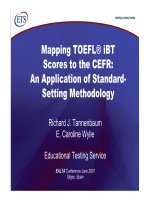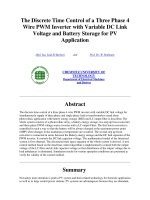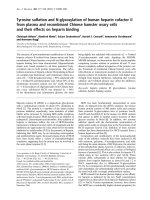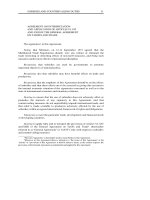The application of islanded photovoltaic cells and battery storage on the reliability of distribution networks
Bạn đang xem bản rút gọn của tài liệu. Xem và tải ngay bản đầy đủ của tài liệu tại đây (2.97 MB, 138 trang )
The Application of Islanded
Photovoltaic Cells and Battery Storage
on the Reliability of Distribution
Networks
Patrick McGrann
Principal Supervisor: Dr. Ghavameddin Nourbakhsh
Associate Supervisor: Gerrard Ledwhich
Submitted in fulfilment for the degree of completion of
Master of Engineering (Research)
School of Electrical Engineering and Computer Science (EECS)
Science and Engineering Faculty (SEF)
Queensland University of Technology (QUT)
Brisbane, Australia
2016
This page is intentionally left blank
Acknowledgements
I would like to express my sincere gratitude to Dr. Ghavameddin Nourbakhsh, who was
my Principal Supervisor for the duration of my thesis. Without Dr. Nourbakhsh’s
enthusiasm for the research and knowledge of the area of study, this thesis would not
have been possible. Dr. Nourbakhsh not only supported my research, but also
introduced me to the research area during my undergraduate studies. I would also like to
acknowledge my Associate Supervisor, Professor Gerrard Ledwhich, whose insights
guided the direction of my research to provide an improved outcome. Furthermore I
would like to thank Associate Professor Geoff Walker for expanding my knowledge of
Photovoltaic generation and Islanding that was critical to my research.
This page is intentionally left blank
Keywords
Monte Carlo, Direct Load Flow, Reliability, Distribution Network, Smart Grid, Micro-Grid,
Distributed Generation, Photovoltaic, Battery Storage, Islanding, Rural, Urban, Renewable
Generation, Load Flow, Intentional Islanding, Load Shedding, Load Curtailment
i
This page is intentionally left blank
Table of Contents
Keywords ....................................................................................................................................... i
Table of Contents ......................................................................................................................... iii
List of Figures ............................................................................................................................... v
List of Tables.................................................................................................................................vi
List of Abbreviations....................................................................................................................vii
Statement of Original Authorship ............................................................................................... viii
Abstract .........................................................................................................................................ix
Chapter 1 Introduction .................................................................................................................. 1
1.1
Background.................................................................................................................... 1
1.1.1
Reliability Simulation ............................................................................................. 3
1.1.2
Network Outage Process ....................................................................................... 3
1.1.3
Distributed Generation ......................................................................................... 4
1.1.4
Battery Storage...................................................................................................... 5
1.1.5
Islanding ................................................................................................................ 5
1.2
Research Justification .................................................................................................... 6
1.3
Research Problems and Research Questions ................................................................ 6
1.4
Research Methodology ................................................................................................. 8
1.5
Organization of the Thesis............................................................................................. 9
Chapter 2 Literature Review ....................................................................................................... 10
2.1
Introduction ................................................................................................................ 10
2.2
Distributed Generation ............................................................................................... 10
2.2.1
Photovoltaic Panels ............................................................................................. 10
2.2.2
Wind Turbine ....................................................................................................... 13
2.2.3
Battery Storage.................................................................................................... 14
2.3
Distribution Network................................................................................................... 15
2.3.1
PV Penetration .................................................................................................... 15
2.3.2
Load Shedding ..................................................................................................... 17
2.3.3
Reactive Power .................................................................................................... 17
2.3.4
Unbalanced Voltage ............................................................................................ 19
2.3.5
Low Voltage Network Modelling ......................................................................... 20
2.3.6
Intentional Islanding............................................................................................ 21
2.4
2.4.1
2.5
Reliability of Distribution Networks ............................................................................ 22
Distributed Generation Effect on Reliability ....................................................... 22
Literature Review Conclusion...................................................................................... 25
Chapter 3 Monte Carlo Development ......................................................................................... 26
iii
This page is intentionally left blank
3.1
Monte Carlo Overview ................................................................................................ 26
3.2
Time Distribution......................................................................................................... 29
3.3
Modelling of a Component State ................................................................................ 32
3.4
Modelling of Network State Events ............................................................................ 33
3.5
Network Configuration................................................................................................ 34
3.6
Outage Results ............................................................................................................ 37
3.6.1
Circuit Breaker ..................................................................................................... 38
3.6.2
Isolators ............................................................................................................... 38
3.6.3
Emergency Ties.................................................................................................... 40
3.7
Direct Load Flow .......................................................................................................... 44
3.8
Load Shedding ............................................................................................................. 51
3.9
Variable Load............................................................................................................... 55
3.10
Photovoltaic Generation ............................................................................................. 58
3.11
Battery Storage ........................................................................................................... 62
3.12
Islanding ...................................................................................................................... 67
Chapter 4 Case Studies................................................................................................................ 70
4.1
Urban Network ............................................................................................................ 70
4.1.1
Default Configuration .......................................................................................... 75
4.1.2
Distributed Generation ....................................................................................... 77
4.1.3
Battery Storage .................................................................................................... 79
4.2
Rural Network ............................................................................................................. 86
4.2.1
Default Configuration .......................................................................................... 91
4.2.2
Distributed Generation ........................................................................................ 93
4.2.3
Battery Storage.................................................................................................... 94
4.3
Discussion .................................................................................................................. 102
4.3.1
Urban ................................................................................................................. 102
4.3.2
Rural .................................................................................................................. 105
Chapter 5 Conclusion ................................................................................................................ 110
5.1
Summary ................................................................................................................... 110
5.2
Future Prospects ........................................................................................................ 112
Appendix A: Yearly Variable Load Data (kW) ............................................................................ 113
Appendix B: Yearly Brisbane Photovoltaic Load Data (kW) ...................................................... 114
References ................................................................................................................................. 115
This page is intentionally left blank
List of Figures
Figure 1 - Typical Daily PV Output and Load Demand [7] ........................................................... 12
Figure 2 - Low Voltage Line Voltage per Photovoltaic Penetration Percentage [7] .................... 15
Figure 3 - Average Percentage of Loads with Voltage Violation [12].......................................... 16
Figure 4 – Voltage Performance with Reactive Power Support [5] ............................................ 18
Figure 5 – Coefficient α at Limits [5] ........................................................................................... 18
Figure 6 - Malaysian Low Voltage Network [7] ........................................................................... 20
Figure 7 - System Reliability with Different Distributed Generation [8] ..................................... 22
Figure 8 - Component State ........................................................................................................ 27
Figure 9 - Component State Timeline ......................................................................................... 28
Figure 10 – Time to Failure.......................................................................................................... 31
Figure 11 - Component State Timeline (Multiple Outages) ........................................................ 32
Figure 12 - Component State Timeline (Single Outage) .............................................................. 32
Figure 13 - Network Events ......................................................................................................... 34
Figure 14 – Isolator Algorithm..................................................................................................... 35
Figure 15 –Normally Open Switch Algorithm .............................................................................. 36
Figure 16 - Simple Distribution Network ..................................................................................... 37
Figure 17 - Simple Network Isolator Result................................................................................. 40
Figure 18 - Simple Network Re-Closer Result ............................................................................. 41
Figure 19 - Direct Load Flow Test Network [30].......................................................................... 45
Figure 20 – BIBC/BCBV generation.............................................................................................. 48
Figure 21 - RBTS Bus 2 Feeder 1 & Feeder 2 ............................................................................... 52
Figure 22 – Load Shedding Selection .......................................................................................... 54
Figure 23 – Daily Load Profile during January ............................................................................. 57
Figure 24 - Daily PV Output during January ................................................................................ 60
Figure 25 - PV Profile vs Load Profile during January .................................................................. 62
Figure 26 - RBTS Bus 2 Feeder 1-2 Battery Placement................................................................ 64
Figure 27 - Islanding Detection Device Location ......................................................................... 67
Figure 28 - RBTS Bus 2 Network Diagram ................................................................................... 71
Figure 29 - RBTS 100% Battery Load Point PIDO ......................................................................... 81
Figure 30 - RBTS 100% Battery Load Point Customer Weighted PIDO ....................................... 81
Figure 31 - RBTS 200% Battery Load Point PIDO ......................................................................... 82
Figure 32 - RBTS 200% Battery Load Point Customer Weighted PIDO ....................................... 82
Figure 33 - RBTS 300% Battery Load Point PIDO ......................................................................... 83
Figure 34 - RBTS 300% Battery Load Point Customer Weighted PIDO ....................................... 83
Figure 35 - RBTS 400% Battery Load Point PIDO ......................................................................... 84
Figure 36 - RBTS 400% Battery Load Point Customer Weighted PIDO ....................................... 84
Figure 37 - RBTS 500% Battery Load Point PIDO ......................................................................... 85
Figure 38 - RBTS 500% Battery Load Point Customer Weighted PIDO ....................................... 85
Figure 39 - SSRTS Rural Network Diagram .................................................................................. 87
Figure 40 - SRRTS 100% Battery Load Point PIDO ....................................................................... 97
Figure 41- SRRTS 100% Battery Load Point Customer Weighted PIDO ...................................... 97
v
This page is intentionally left blank
Figure 42 - SRRTS 200% Battery Load Point PIDO ....................................................................... 98
Figure 43 - SRRTS 200% Battery Load Point Customer Weighted PIDO...................................... 98
Figure 44 - SRRTS 300% Battery Load Point PIDO ....................................................................... 99
Figure 45 - SRRTS 300% Battery Load Point Customer Weighted PIDO...................................... 99
Figure 46 - SRRTS 400% Battery Load Point PIDO ..................................................................... 100
Figure 47 - SRRTS 400% Battery Load Point Customer Weighted PIDO.................................... 100
Figure 48 - SRRTS 500% Battery Load Point PIDO ..................................................................... 101
Figure 49 - SRRTS 500% Battery Load Point Customer Weighted PIDO.................................... 101
Figure 50 - SRRTS Load Point 1 January PV & Load Profile ....................................................... 105
This page is intentionally left blank
List of Tables
Table I - Malaysian LV Network Characteristics .......................................................................... 20
Table II – Network Component State Array ................................................................................ 33
Table III - Network Outage Event States ..................................................................................... 34
Table IV - Circuit Breaker Outage Output ................................................................................... 38
Table V – Isolator Input ............................................................................................................... 39
Table VI - Simple Network Load Point Results w/o Re-Closer .................................................... 41
Table VII - Simple Network Load Point Results w. Re-Closer ...................................................... 42
Table VIII - Simple Network Load Point Results w. Re-Closer + added Isolator .......................... 43
Table IX - Simple Network Analytical Results .............................................................................. 43
Table X – Load Flow Test Results ................................................................................................ 50
Table XI - Load Flow Data w/o fault ............................................................................................ 53
Table XII - Created Load Flow Data with Re-Closer ..................................................................... 53
Table XIII – SolaGrid ESS 20 [35].................................................................................................. 63
Table XIV - S&C PureWave Storage Management System [36] .................................................. 64
Table XV - RBTS Bus 2 Load Point Data ....................................................................................... 72
Table XVI - RBTS Bus 2 Load Flow Line Parameters .................................................................... 73
Table XVII - Conductor Impedance per km ................................................................................. 74
Table XVIII - RBTS Bus 2 Reliability Data...................................................................................... 74
Table XIX - RBTS Bus 2 Base Reliability Results ........................................................................... 75
Table XX - RBTS Bus 2 Load Point Failure Rates .......................................................................... 76
Table XXI - SRRTS PV Generation ................................................................................................ 77
Table XXII - RBTS Bus 2 PV Results .............................................................................................. 78
Table XXIII - RBTS Bus 2 Load Point Battery Units ....................................................................... 79
Table XXIV - RBTS Bus 2 Battery Test Cases ................................................................................ 79
Table XXV - RBTS Bus 2 Battery Test Case Results ...................................................................... 80
Table XXVI - SRRTS Load Point Data ............................................................................................ 88
Table XXVII - SRRTS Load Flow Line Parameters ......................................................................... 89
Table XXVIII - SRRTS Reliability Data ........................................................................................... 90
Table XXIX - SRRTS Base Reliability Results ................................................................................. 91
Table XXX - SRRTS Monte Carlo Load Point Results .................................................................... 92
Table XXXI - SRRTS PV Generation .............................................................................................. 93
Table XXXII - SRRTS with PV Reliability Results ........................................................................... 94
Table XXXIII - SRRTS 100% Battery Quantity ............................................................................... 95
Table XXXIV - SRRTS Battery Test Cases ...................................................................................... 95
Table XXXV - SRRTS Battery Test Case Results ............................................................................ 95
Table XXXVI - RBTS Bus 2 Battery Test Case Analysis #1 ........................................................... 103
Table XXXVII - RBTS Bus 2 Battery Test Case Analysis #2 .......................................................... 104
Table XXXVIII - SRRTS Battery Test Case Analysis #1................................................................. 106
Table XXXIX - SRRTS Battery Test Case Analysis #2 ................................................................... 106
Table XL - SRRTS ENS Savings .................................................................................................... 108
Table XLI - SRRTS New 100% Battery Quantity ......................................................................... 109
Table XLII - SRRTS New Battery Test Case ................................................................................. 109
vi
This page is intentionally left blank
List of Abbreviations
DG
Distributed Generation
LV
Low Voltage
MV
Medium Voltage
DSP
Distribution Service Provider
PV
Photovoltaic
MC
Monte Carlo
SAIDI
System Average Interruption Duration
Index
SAIFI
System Average Interruption Frequency
Index
ENS
Energy Not Supplied
GENE
Generated Energy Not Exported
PIDO
Probability of Island During Outage
TTF
Time to Failure
TTS
Time to Switch
TTR
Time to Repair
vii
This page is intentionally left blank
Statement of Original Authorship
The work eontained in this thesis has not been submitted previously to meet requirement
of
an award at this or any other higher education institution. To the best of my knowledge and
belief, the thesis contains no material previously published or written by another person
except where due reference has been made.
Patrick McGrann
QUT Verified Signature
Signatu
Dare: a 1/i a 71 lb
vilt
This page is intentionally left blank
Abstract
It is important for distribution service providers to maintain reliable distribution
networks, as they are required to meet reliability standards. Additionally, energy not
supplied to a customer during an outage is a loss of potential revenue. Therefore
minimizing the outage durations are essential. Traditionally the outage duration has
been reduced by incorporating protection devices that will isolate the fault, so that load
points may be restored. In the event that the load point is unable to be restored to the
main supply, alternate feeders have the potential to resupply the loads through the use of
an emergency tie. However, not all networks allow for the possibility of emergency ties
due to the geographical spread of the loads, which is particularly apparent in rural
distribution networks. Therefore the only method to restore power to the isolated loads
is to utilize intentional islanding. Although islanding is not currently allowed under
Australian Standards, it can provide significant improvements to unreliable networks.
With islanding, load points or groups of load points are able to self-supply their load
using local generation. There already exists high photovoltaic penetration in distribution
networks, but the generation required to provide islanding will cause over voltage issues
in the network. In addition to this, the peak of photovoltaic generation will occur at an
offset time to the peak demand of the loads and therefore the excess generation is not
efficiently used. To overcome this by curtailing the peak demand and reducing the
excess generation, battery storage can be installed in the distribution network. This will
reduce the over voltage issues and provide enough generation to sustain the load points
during an outage under islanding conditions. A Monte Carlo simulation, coupled with
load flow was developed to be used as time based reliability tool. Using this, an urban
and a rural network were tested with incrementing levels of battery storage. Due to a
lack of emergency ties and poor reliability of rural networks, it was determined that
allowing for intentional islanding, through the increase of battery storage levels, a
positive effect can be had on the reliability of the network. It was then concluded that
the cost can only be justified when considering the load curtailment benefits of
including battery storage, rather than solely considering reliability.
ix
Chapter 1
Introduction
This chapter provides background information on the current reliability of distribution
networks. It will introduce the Monte Carlo and Direct Load Flow methods for
calculating the reliability of a network. Finally, it will outline smart grid technologies
and methods proposed to improve the reliability of distribution networks, such as
Photovoltaic panels, battery storage and intentional islanding.
1.1 Background
Distribution Service Providers (DSP) provide a connection between the
transmission network to residential, industrial, commercial and agricultural loads.
Traditionally, urban distribution networks consist of a mesh layout, however due to
the large geographical spread of customers in rural networks, they tend to consist
of a radial layout. In a radial network a feeder has a single point of connection to
the grid. Therefore a fault occurring on a feeder can cause the outage of all loads
downstream from the fault if the isolation of the fault causes a break in the path of
supply. This contributes to rural networks having worse reliability indices, which
DSP are required to keep to a set standard or face penalties. In addition to the
required standard, improving the reliability indices of the network further will
reduce the energy not supplied to the customers, therefore reducing the cost to the
DSP.
Over recent years the number of high power consuming devices in
residential loads has increased, leading to a rise in the daily peak and yearly
average loads of distribution networks. This has resulted in causing strain to the
network components capacity, leading to degradation of the network reliability.
1|Page
A number of upgrades can be performed to network components to improve the
reliability of the network, such as the instalment of Distributed Generation (DG)
sources. There are many feasible forms of DG technologies available, such as
diesel generators, wind turbines and fuel cells. However, with the recent
advancements and wide spread implementation of Photovoltaic (PV) panels to Low
Voltage Networks, there is currently a basis available to improve the reliability
indices through supplying the network loads and improving the power quality.
The total penetration of PV, as well as the ratio of PV across each feeder, can
drastically affect the voltages across the distribution network. With the addition of
battery storage most of the issues caused by high PV penetration can be addressed,
such as storing unused energy and reactive power correction. Given the
fluctuations of household PV power output and loads throughout the day and year,
a time-based simulation is required to accurately calculate the reliability indices.
Monte Carlo simulation is a probabilistic time-based simulation method that can
achieve the desired results. The reliability of LV networks, power quality issues
associated with DG in LV networks and placement of DG must be further
investigated before creating a Monte Carlo simulation to determine their effects.
Research into the modelling of various distributed generation sources, battery
storage and alternative reliability calculation methods are required.
2|Page
1.1.1
Reliability Simulation
Traditionally, the reliability of a distribution network has been calculated through an
enumeration method. For first order operations only, this analytical-type method also
determines which component failures will cause a load point to be forced on outage and
then enumerates the failure rates, repair times and switching times associated with these
components to determine the reliability indices. This provides very fast and fairly
accurate calculations, but at the cost of detail. The method is not time based and is
therefore unable to accurately model daily load profiles and the seasonal changes.
Alternatively, the Monte-Carlo method can be used, which consists of a time-based
simulation, replicating the behaviour of a distribution network. Using the average fault
rates, repair times and switching times of components, randomly distributed times are
generated to calculate the life of each component. Based on these times, the reliability
indices can then be calculated, similarly to the enumeration method. As it is a timebased simulation, variable loads and variable generation profiles, as well as seasonal
changes can be included. Additionally, the results from each year of simulation can be
used to display the distribution of results that is not possible with the analytical method.
As the Monte Carlo method is not limited to the number of simultaneous faults, any
combination of failures is possible, but due to the rarity of multiple failures, they will
have minimal impact on the reliability indices.
1.1.2
Network Outage Process
When a component in a network such as a line, bus or transformer fails, load outage
may occur. Upon a fault event, initially a circuit breaker normally located upstream at
the supply point on a feeder directly connected to the fault will open, thereby
disconnecting power to the feeder. During this stage all load points in the network will
be on outage, unless the fault occurs on a lateral line protected by a fuse. In this
situation, only load points connected downstream from the fuse will be on outage. The
time it takes for the fault to be isolated (an average time using enumeration technique
and a variable time based on a distribution for a Monte Carlo method) is dependent on
the network and represents the time it takes for technicians to find and isolate the fault.
3|Page
Thereafter, circuit breaker is closed and all load points that are no longer connected to
the fault, but still have a line of supply to the main feeder or an alternative feeder will
no longer be on outage. However, if the supply of these loads cause any voltage
violations or the demand is unable to be met, load shedding will be performed.
Following this the repair stage will begin, with the network remaining in the same state
while technicians work to repair the faulty component. When this time has elapsed and
the fault cleared, the network can return to an operating state with all load points being
fully restored. When the initial fault occurs, all PV inverters in the network will
disconnect to avoid supplying the fault and to avoid creating hazardous conditions for
the network technicians. This process is altered when islanding is being used in the
network. An island is a group feeders and loads or load points that are connected
together in a locality to attempt to self-supply without a connection to the network.
Therefore depending on the control scheme used for isolating the island from the
network during an outage, the island can be formed instantly during the initial switching
state or it can be created when the isolators have been opened to isolate the fault. If the
island is able to sustain its loads or partial loads, the load points (or some of the load
points) will remain operational for the duration of the outage event, regardless of the
rest of the network’s configuration.
1.1.3
Distributed Generation
A DG source is any device with a generation below ~10MW. There are many feasible
DG technologies currently available, such as diesel generators, wind turbines, fuel cells
and photovoltaic panels.
Diesel Generators are traditionally used during a scheduled repair, or as an
emergency backup supply. Due to influencing factors of noise, cost of running
and sustainability, this is not a long term device for a smart grid.
Although micro-turbines exist, wind generation in Australia is generally used at
a higher level and not as a local distribution source in the low voltage network.
Photovoltaic (PV) panels have seen a dramatic increase in Australia due to the
high solar radiation, availability, small size and economic benefits.
4|Page









![thang nguyen ngoc - 2011 - corporate governance and its impact on the performance of firms in emerging countries - the evidence from vietnam [cg]](https://media.store123doc.com/images/document/2015_01/02/medium_rfd1420194809.jpg)